Ever wonder why your social media feed feels like it was made just for you? That’s because it pretty much is. Behind the scenes, algorithms—those sneaky bits of code—are working overtime, serving up content they think you’ll love. Sounds great, right? But here’s the catch: while they’re showing you things you enjoy, they’re also quietly shaping how you see yourself and the world around you. Let’s unpack this in plain English.
What Are Algorithms Really Doing?
Think of social media algorithms as your personal assistant. They’re tracking what you like, comment on, and share to figure out what keeps you scrolling. Their job? To make sure you spend as much time on the app as possible. That’s why your feed is filled with stuff you care about—funny memes, workout videos, or the latest trends.
But here’s the thing: by constantly serving up what you already like, algorithms can limit what you see. It’s like always eating at the same restaurant—you never know what other amazing dishes are out there!
How Algorithms Shape What You See—and How You Feel
Social media isn’t just a place to post selfies and scroll memes. It’s also where we figure out who we are and what we care about. The catch? Algorithms are running the show behind the scenes, deciding what you see based on what you already like. Sounds convenient, right? Sure—but it’s not all sunshine and rainbows. Let’s dive into how this all works and what it means for you.
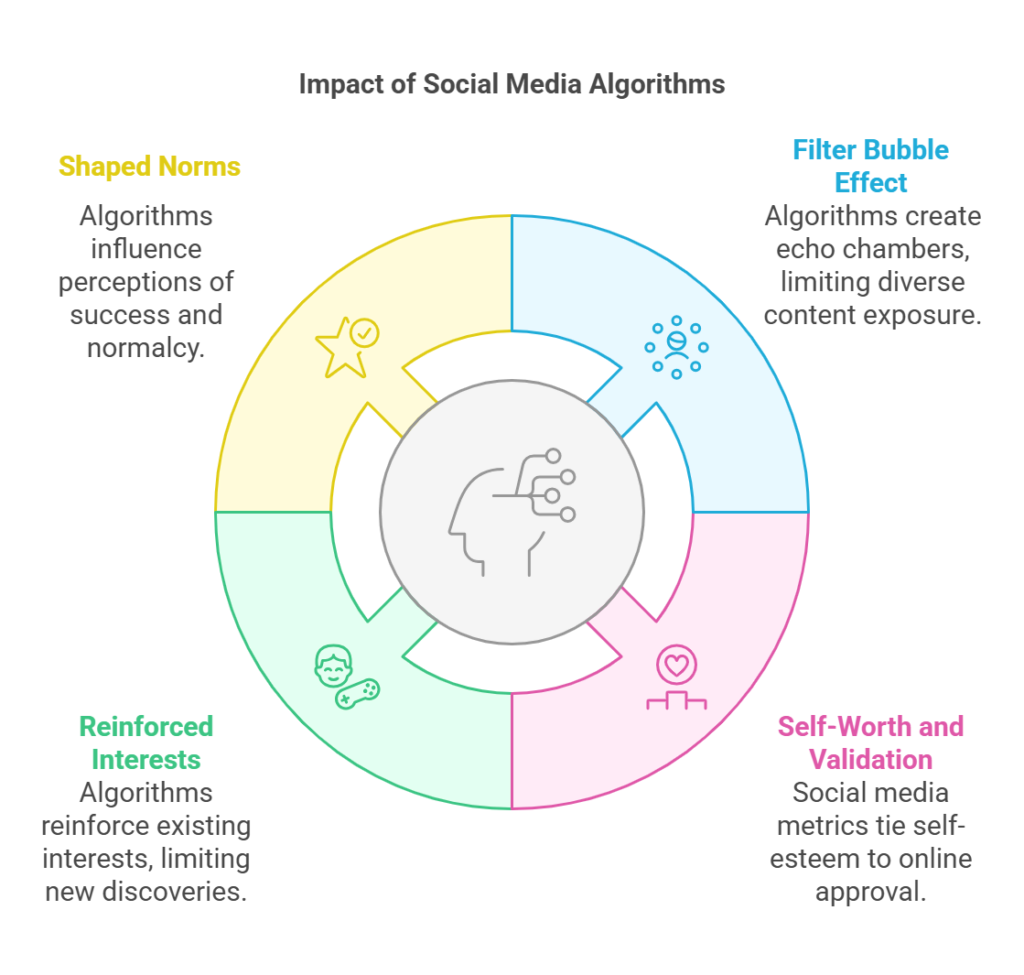
The Filter Bubble: A Skewed Reality
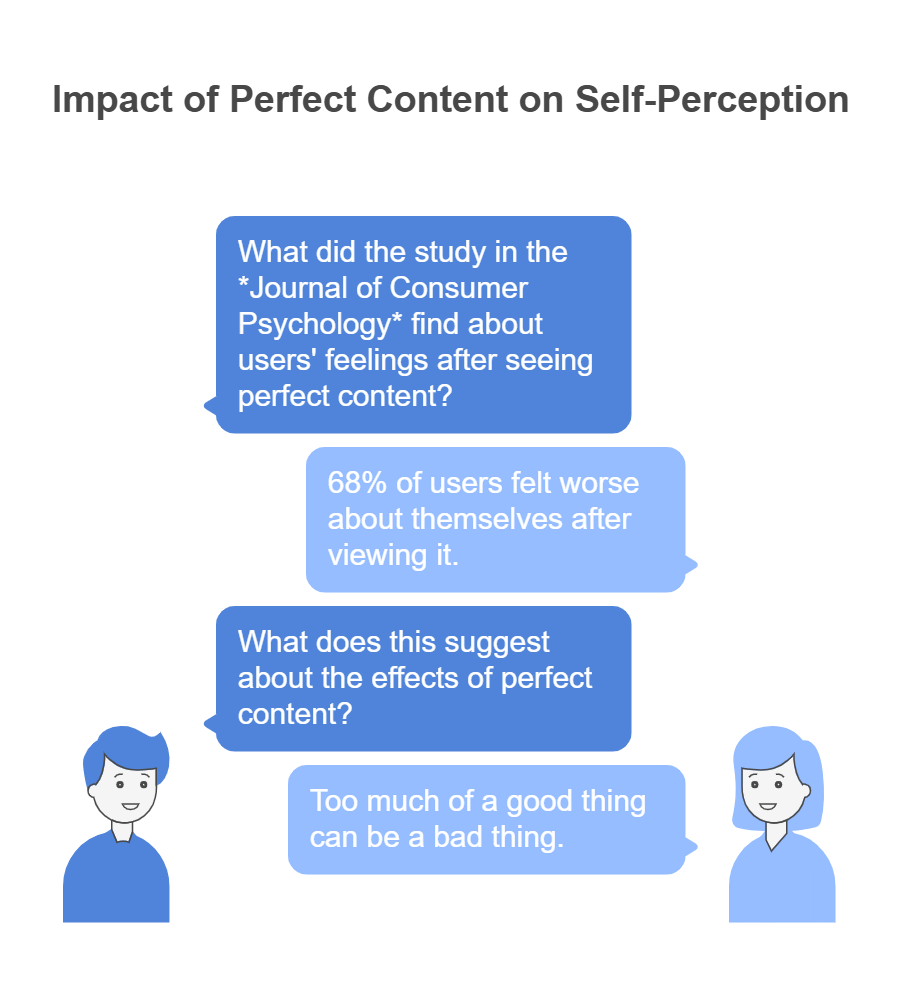
Ever notice how your feed feels like an echo chamber? That’s the “filter bubble” at work. Algorithms show you content that matches your interests and skip over the stuff that doesn’t. For example If you’re into fitness, your feed might be flooded with workout routines and pictures of people with six-pack abs. While that can be motivating, it can also lead to some not-so-great side effects, like constant self-comparison.
The Numbers:
A study in the Journal of Consumer Psychology found that 68% of users felt worse about themselves after seeing all that “perfect” content. Turns out, too much of a good thing can be a bad thing.
Social Media and Self-Worth: The Validation Game
Let’s be real—social media loves turning life into a popularity contest. Likes, comments, and shares feel like little hits of approval, so it’s no wonder we start tying our self-worth to those numbers.
What happens next? People start posting what they think will get the most likes, even if it’s not 100% authentic. It’s like swapping your comfy jeans for something trendy but uncomfortable—you might look good, but it doesn’t feel like you.
Algorithms and Your Identity
Social media isn’t just about scrolling; it’s where we figure out who we are—or at least try to. And algorithms? They’re like the friend who only talks about what you already love, keeping things familiar but not exactly adventurous.
- Reinforcing the Same Old You:
Love fitness? Your feed will probably keep feeding you workout videos, meal prep ideas, and gym selfies. Sure, that’s great for motivation, but it might also box you in. Who knows what cool, new interests you’re missing out on? - Shaping What’s “Normal”:
Algorithms love juicy, emotionally charged content because it gets more reactions. That viral post about grinding 24/7 might have you rethinking what success means—even if you don’t agree with it deep down.
How Algorithms Shape What We Believe
Social media algorithms are like invisible puppeteers, deciding what we see—and what we don’t. While they can make our feeds feel personal and relevant, they also play a sneaky role in shaping how we view the world. Let’s unpack how this works and why it matters.
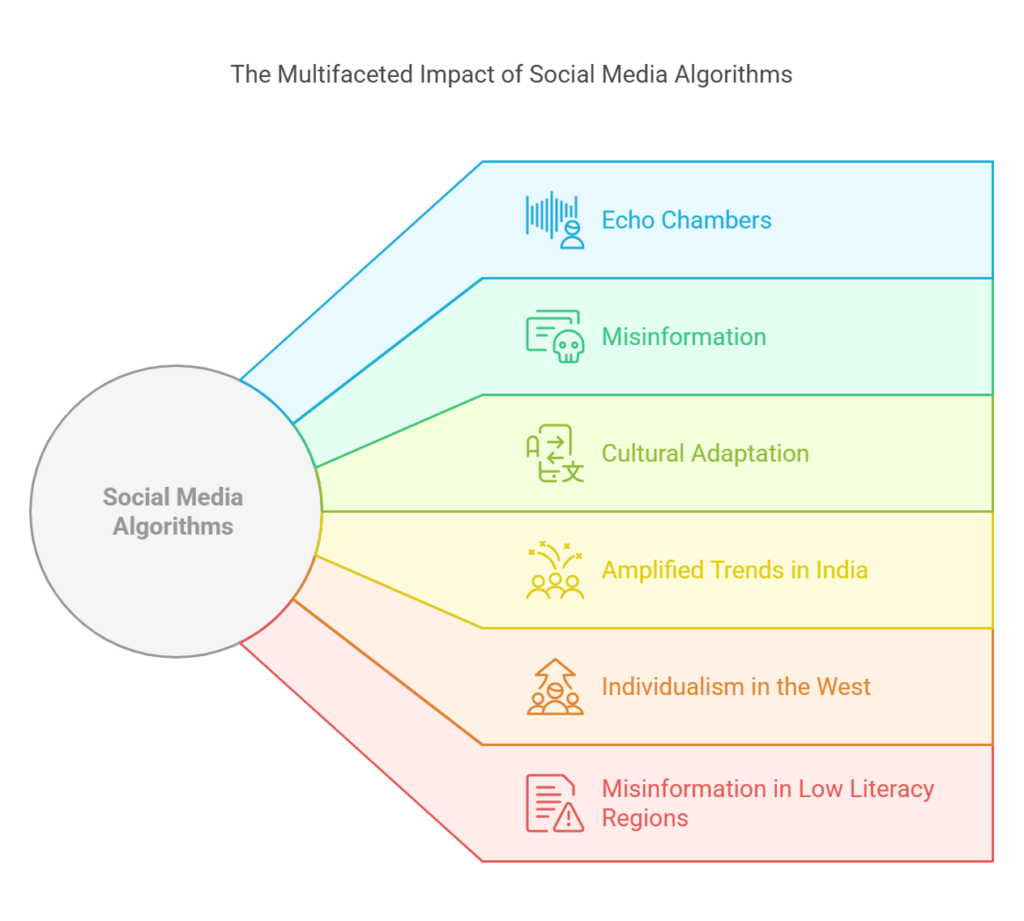
Echo Chambers: The Same Voices on Repeat
Algorithms love engagement, and what gets the most clicks? Content that stirs emotions—whether it’s outrage, joy, or shock. The result? Your feed fills up with perspectives that match your own, creating an echo chamber.
A Pew Research study found that over half (55%) of social media users mostly see political content that aligns with their own views. Meanwhile, only 20% are exposed to opposing opinions. It’s like sitting in a room where everyone nods in agreement—comforting, but not exactly eye-opening.
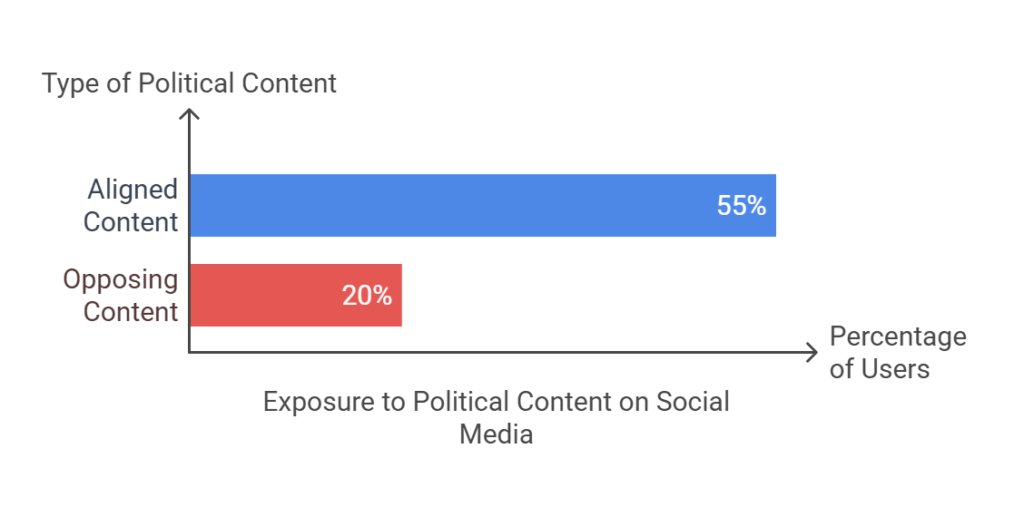
When we only see one side of the story, our worldview can narrow. It’s easy to feel like “everyone” thinks the same way, even when that’s far from true.
Misinformation: The Sensational Gets Center Stage
Here’s a not-so-fun fact: sensational content—like shocking headlines or too-good-to-be-true claims—gets way more engagement than straightforward facts. And algorithms? They eat it up.
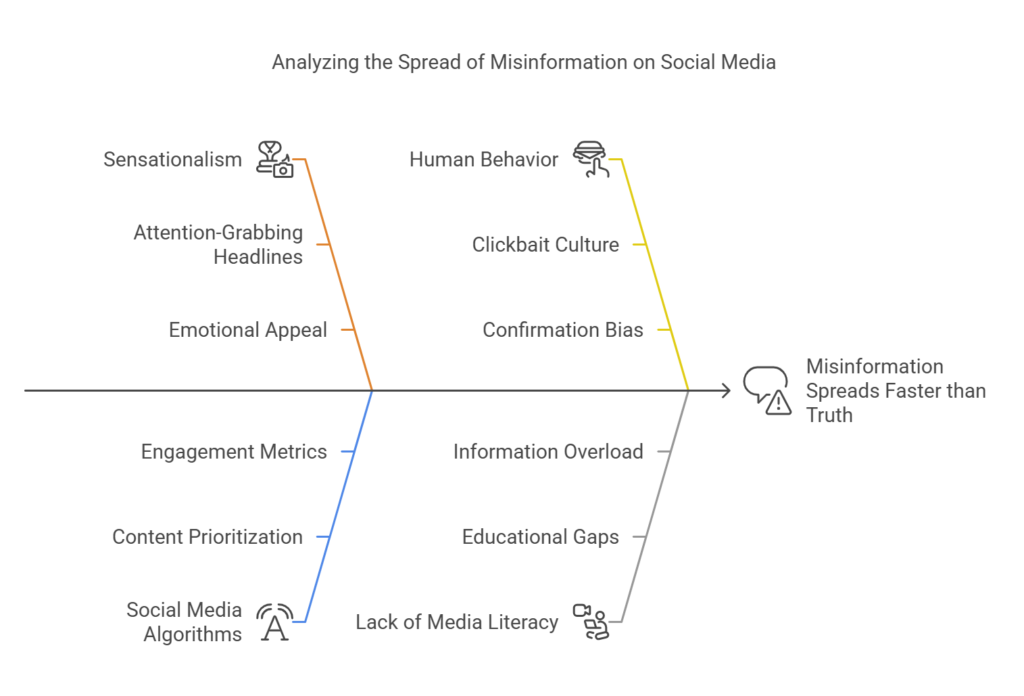
For example -A 2018 study in Science found that false news spreads six times faster than the truth on social media. Why? Because sensational content grabs attention and keeps us clicking, even if it’s not accurate. From climate change to public health, misinformation shapes how we see critical issues, often distorting reality.
Algorithms Around the World: Not One-Size-Fits-All
Algorithms don’t work the same way everywhere—they adapt to cultural contexts and user behaviors. Here’s how they play out globally:
In India: Amplifying Trends and Groupthink
Social media in India plays a massive role in shaping opinions, especially as the country undergoes rapid digital growth. Algorithms tend to amplify cognitive biases, like the “bandwagon effect,” where people jump on popular trends without questioning them.
Singh and Khatri (2023) found that Indian users experience heightened polarization due to algorithm-driven content, which reinforces distinct identity groups.
In Western Countries: Individualism and Success Stories
In the West, algorithms often lean into themes of personal achievement and self-expression. Think of all the posts about career wins, fitness transformations, or creative projects. While this can be inspiring, it can also fuel a competitive, success-driven mindset.
In Regions With Low Digital Literacy: Misinformation Risks
In places where digital literacy is lower, algorithms can inadvertently amplify misinformation. Without the skills to fact-check, users may take everything they see online at face value, which can have serious implications for how they perceive global and local issues.
How Algorithms Affect Offline Behavior
It’s not just about what happens online. Social media algorithms can nudge us into action—or inaction—in the real world.
- Civic Participation: A study by Jung, Dai, and Albarracín (2023) shows how algorithms can promote offline civic engagement by curating posts that inspire activism. However, they can also create a “slacktivism” effect, where people feel like sharing a post is enough.

- Group Identity: Algorithms encourage strong in-group connections, but this can lead to “us vs. them” mentalities, especially when paired with polarizing content.
The Role of AI in Shaping Your Worldview
Here’s where it gets really interesting. AI-driven algorithms are designed to adapt to your behavior, creating a personalized experience that feels almost too good. Platforms like TikTok and Instagram don’t just guess what you like—they learn it, constantly evolving based on your every move. But this raises a few questions:
- Are You in Control?: With algorithms doing the heavy lifting, are you choosing your identity, or is it being chosen for you?
- Ethical Concerns: Should platforms be responsible for mitigating the negative effects of their algorithms, like polarization and misinformation?
How to Take Control of Your Feed (And Your Identity)
- Spot the Echo Chamber
If all the content in your feed reinforces the same opinions, diversify it. Follow accounts with differing viewpoints to challenge the algorithm. - The 3-Minute Pause Rule
Before reacting to sensational content, pause for three minutes. This prevents emotional engagement with clickbait designed to trigger you. - “Why Am I Seeing This?” Check
Many platforms offer explanations for why content appears in your feed. Use this feature to understand what’s driving recommendations. - Engage Intentionally
Treat every like, comment, and share as a signal. Only interact with content that aligns with your values and interests. - Diversify Your Engagement
Search for topics you’re not typically shown. This disrupts the algorithm’s assumption about your preferences. - Set a “Scroll Ceiling”
Decide in advance how much time you’ll spend on social media. Use timers or app limits to avoid falling into endless scrolling traps. - Unfollow the Noise
Regularly audit your feed and unfollow accounts that contribute to negativity or unnecessary comparison. - Go Manual with News
Avoid relying solely on social media for updates. Bookmark credible news sources and visit them directly. - “Feed Detox” Day
Once a week, mute or unfollow everything non-essential for 24 hours. Reset what the algorithm learns from you. - Check Your Mood
After a scrolling session, ask: How do I feel? If it’s drained or anxious, adjust the accounts or content you engage with. - Use Keywords to Explore
Search for specific, non-algorithm-driven content using keywords. This takes control away from the platform’s automatic suggestions. - Limit Emotional Shares
Before sharing content, ask yourself: Am I sharing this to inform or react? Avoid amplifying emotional or divisive posts. - Engage in “Offline Firsts”
Explore new hobbies or conversations offline before looking them up online. This keeps the algorithm from predefining your interests. - Keep Track of Patterns
If you notice recurring themes or ads, take note. It’s a sign of what the algorithm thinks you’re interested in—and an opportunity to recalibrate. - Mute Ads That Feel Too Targeted
Most platforms let you hide or mute ads. Use this feature liberally to stop feeling “watched.”
These tips can help you maintain control over your digital experience while ensuring that social media serves you, not the other way around.
Final Thoughts: Writing Your Own Narrative
Social media algorithms aren’t evil—they’re just doing their job. But by understanding how they work, you can use them to your advantage instead of letting them shape your identity and worldview without you even noticing.
Next time you’re scrolling, ask yourself: Is this really me, or is this the algorithm’s version of me?
References & links to Study
- The Filter Bubble Effect on Mental Well-being
- Source: Journal of Consumer Psychology
- Finding: 68% of users felt worse about themselves after exposure to “perfect” content.
- Access Link
- Echo Chambers and Polarization on Social Media
- Source: Pew Research Study
- Finding: 55% of users see content aligning with their views, while only 20% are exposed to opposing opinions.
- Access Link
- The Spread of False News on Social Media
- Source: Science (2018)
- Finding: False news spreads six times faster than the truth.
- Access Link
- Algorithms and Civic Participation
- Source: Jung, Dai, and Albarracín (2023)
- Finding: Algorithms promote offline civic engagement but may also create “slacktivism.”
- Access Link
- Social Media Amplifying Cognitive Biases in India
- Source: Singh and Khatri (2023)
- Finding: Algorithms reinforce the bandwagon effect, increasing polarization.
- Access Link
- Cognitive Science of Memory and Chunking
- Source: Trends in Cognitive Sciences
- Finding: Chunking reduces cognitive load, improving retention by up to 20%.
- Access Link







